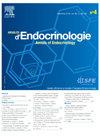Body composition in a pediatric population with type-1 diabetes – The importance of planned physical exercise
IF 2.9
3区 医学
Q3 ENDOCRINOLOGY & METABOLISM
引用次数: 0
Abstract
Objective and methods
This study aimed to assess the body composition of pediatric patients with type-1 diabetes (T1D) in a Portuguese pediatric endocrinology/diabetic clinic, using the InBody 570 bioimpedance system. Preschool children (< 6 years) and those recently diagnosed (< 6 months) were excluded.
Results
The study included 78 patients (53% female). Median age at assessment was 14 years, with 81% pubertal children. Eighty-seven percent were using continuous subcutaneous insulin infusion (CSII), 25% with an automated closed-loop model. Median HbA1c was 7.3%. Most had an adequate body mass index (BMI) standard deviation score (62%) and 48% engaged in regular physical exercise (PE) outside of school. Median percentage body fat (PBF) was 21.5% and was abnormal in 48%, with median visceral adiposity of 4. Despite adequate BMI, 11% had excessive PBF. PBF was significantly associated with visceral fat (r = 0.79; P < 0.001), female gender (P < 0.001) and PE performed out of school (P = 0.005). PE was associated with lower PBF (P = 0.005), lower visceral fat (P = 0.002), and higher muscle-to-fat ratio (P = 0.006).
Conclusion
Engaging in physical exercise out of school correlated significantly with improved body composition, characterized by reduced PBF and diminished visceral adiposity. Considering the known benefits of physical exercise for metabolic and glycemic control, this study highlights the importance of promoting regular physical exercise in T1D patients.
1 型糖尿病患儿的身体成分--有计划的体育锻炼的重要性。
目的和方法:本研究旨在使用 InBody 570 生物阻抗系统评估葡萄牙一家儿科内分泌/糖尿病诊所的 1 型糖尿病(T1D)儿科患者的身体成分。学龄前儿童(小于 6 岁)和最近确诊的儿童(小于 6 个月)被排除在外:研究共纳入 78 名患者(53% 为女性)。评估时的中位年龄为 14 岁,其中 81% 为青春期儿童。87%的患者使用连续皮下胰岛素输注(CSII),25%使用自动闭环模式。HbA1c 中位数为 7.3%。大多数人的体质指数(BMI)标准偏差分值适当(62%),48%的人定期参加校外体育锻炼(PE)。体脂百分比(PBF)中位数为 21.5%,48% 的人体脂百分比异常,内脏脂肪含量中位数为 4。体脂率与内脏脂肪有明显的相关性(r=0.79;p):在校外参加体育锻炼与身体成分的改善有明显的相关性,其特点是 PBF 降低和内脏脂肪减少。考虑到体育锻炼对代谢和血糖控制的益处,本研究强调了促进 T1D 患者定期进行体育锻炼的重要性。
本文章由计算机程序翻译,如有差异,请以英文原文为准。
求助全文
约1分钟内获得全文
求助全文
来源期刊

Annales d'endocrinologie
医学-内分泌学与代谢
CiteScore
4.40
自引率
6.50%
发文量
311
审稿时长
50 days
期刊介绍:
The Annales d''Endocrinologie, mouthpiece of the French Society of Endocrinology (SFE), publishes reviews, articles and case reports coming from clinical, therapeutic and fundamental research in endocrinology and metabolic diseases. Every year, it carries a position paper by a work-group of French-language endocrinologists, on an endocrine pathology chosen by the Society''s Scientific Committee. The journal is also the organ of the Society''s annual Congress, publishing a summary of the symposia, presentations and posters. "Les Must de l''Endocrinologie" is a special booklet brought out for the Congress, with summary articles that are always very well received. And finally, we publish the high-level instructional courses delivered during the Henri-Pierre Klotz International Endocrinology Days. The Annales is a window on the world, keeping alert clinicians up to date on what is going on in diagnosis and treatment in all the areas of our specialty.
 求助内容:
求助内容: 应助结果提醒方式:
应助结果提醒方式:


